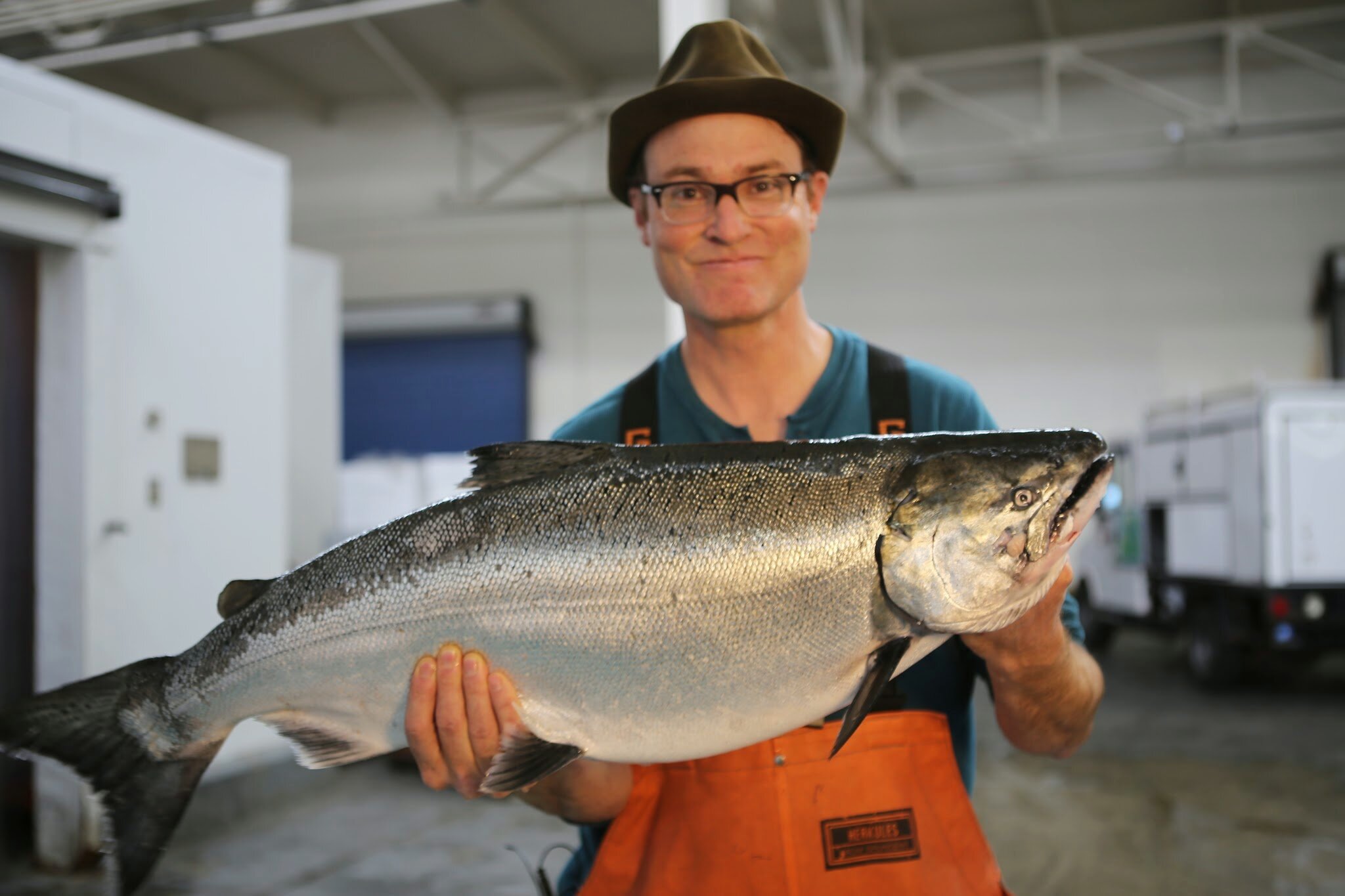Chinook "King" Salmon
Also called King Salmon. They are native to the north Pacific Ocean and the river systems of western North America ranging from California to Alaska.
Availability: Spring, Summer, Fall
The Meat
In my humble opine there's nothing quite like the fresh local chinook. That's one reason why it goes for $25-$30 a pound in the market. It's hard to come up with ways to ruin salmon. I like mine grilled. The fishwife is a master of the miso-glaze which involves broiling/baking. Last night I was lazy so I just pan-seared a slab, squeezed a lemon on it and called it done.
Prep
Salmon will always come filleted. Unless you request a whole fish.
Gear and fishery info
Back in the 19th century, salmon were slaughtered in every conceivable way: gill net, purse seine, trot line, you name it (depth charge anyone?) The numbers in those days were so incredible, everyone thought the fish would last forever—kinda like buffalo that way. Canneries lined the Sacramento river for miles. Some time in the 1930s (or was it the 50s?) , with salmon stocks plummeting the state mandated a troll-gear-only fishery for California chinook salmon. And that's how it has remained to this day. Here's some footage of Mikey and I catching salmon with troll gear in August 2013.
Troll boats (not to be confusewd with "trawl boats" by the way) use wire cables with fishing leaders attached. The fisherman winches the salmon up to the boat on a gurney, then for the last 20 feet or so, pulls the fish in by hand. All commercially caught local chinook salmon were either reeled or hand-lined to the boat this way. Now try to imagine what that's like on a 100 fish day! I could write on this subject for many hours, so I'm gonna cut myself off here. I will post more stuff on salmon in the days and weeks to come. Suffice it to say we are at the end of what has been a truly epic salmon season.
#KnowYourFisherman
Our Salmon is caught by Captain Jake Bunch, F/V Sadie K and Nico "Sharky" Von Broembsen, F/V Golden Girl
Fish Nerdism 101
In a perfect world all salmon would spawn naturally. But alas the world ain't perfect. Because human beings destroyed many of the spawning areas in the headwaters of the tributary creeks of the Sacramento (and other CA rivers), it became necessary to build hatcheries. Hatcheries take an essentially wild fish and assist it in it's final (and initial) stages of reproduction. Salmon activists argue that hatcheries pollute the gene pool by selecting for fish that succeed in hatcheries—not necessarily in the wild.
But most people feel that our hatchery system saved the California chinook salmon and that there would be no (or very few) salmon for sport or commercial fisheries, if it were not for hatcheries. My good friend in the fish, and salmon activist, Walter "Walto-pedia" Jorgensen is about to blow a fuse over this last sentence. Sorry Walt. FYI: a hatchery and a fish farm are two very different things. A salmon farm is where salmon are raised and kept in pens from cradle to the grave. A hatchery by contrast assists in the first and last stages of a salmon's life cycle. What it does in between these events is its own business.
Health concerns
The chinook salmon is nature's miracle fish; a predatory species that is low in all the bioaccumulated toxins and high in all the good stuff.
Parting Shots
4 years ago our salmon stocks took a tremendous dive. Everybody from fishermen to biologists were in agreement that something had to be done. All fishing was closed for two years. But more importantly, there was a change in water distribution made possible by a federal judge whose name unfortunately escapes me now. Then for two springs in a row it rained. Simultaneously we had three years of fantastic upwelling off shore. Guess what? The salmon returned with a vengeance. Moral of the story? Not sure, really. But we should probably remember that salmon populations are subject to peaks and valleys, and that water distribution (from the Sacramento) and ocean conditions are the key components to a successful salmon fishery.
Recipes
Facts
Scientific Name: Oncorhynchus tshawytscha
Habitat: Freshwater rivers and estuaries - ocean and sea. Chinook salmon may spend between 1 to 8 (the average is 3 to 4) years in the ocean before returning to their natal streams to spawn.
Diet: Planktonic diatoms, copepods, jellyfish, krill, other fishes & etc.
Size: Adult fish range in size from 24 to 36 inches, but may be up to 58 inches in length; they average 10 to 50 pounds, but may reach 130 pounds.
Range: Native to the Pacific Ocean, then range from Alaska to California.






"My favourite minimal preparation is carpaccio. It’s incredibly simple to make and almost impossible to mess up, it can mostly be prepared in advance, and it's a great showcase of the fish's natural texture and flavour.